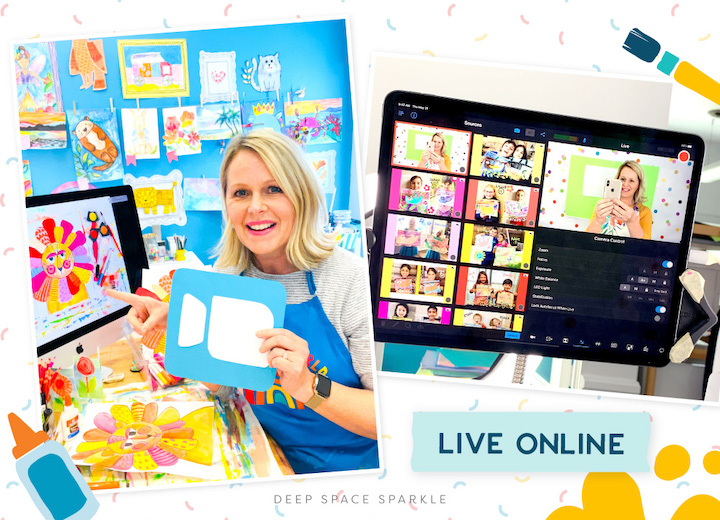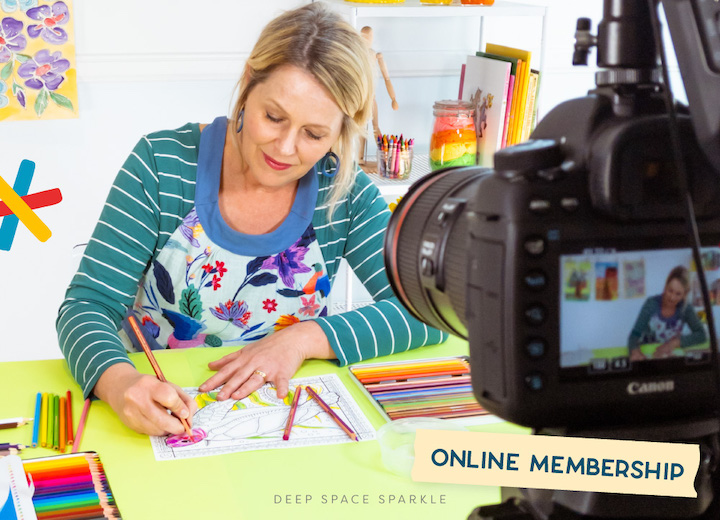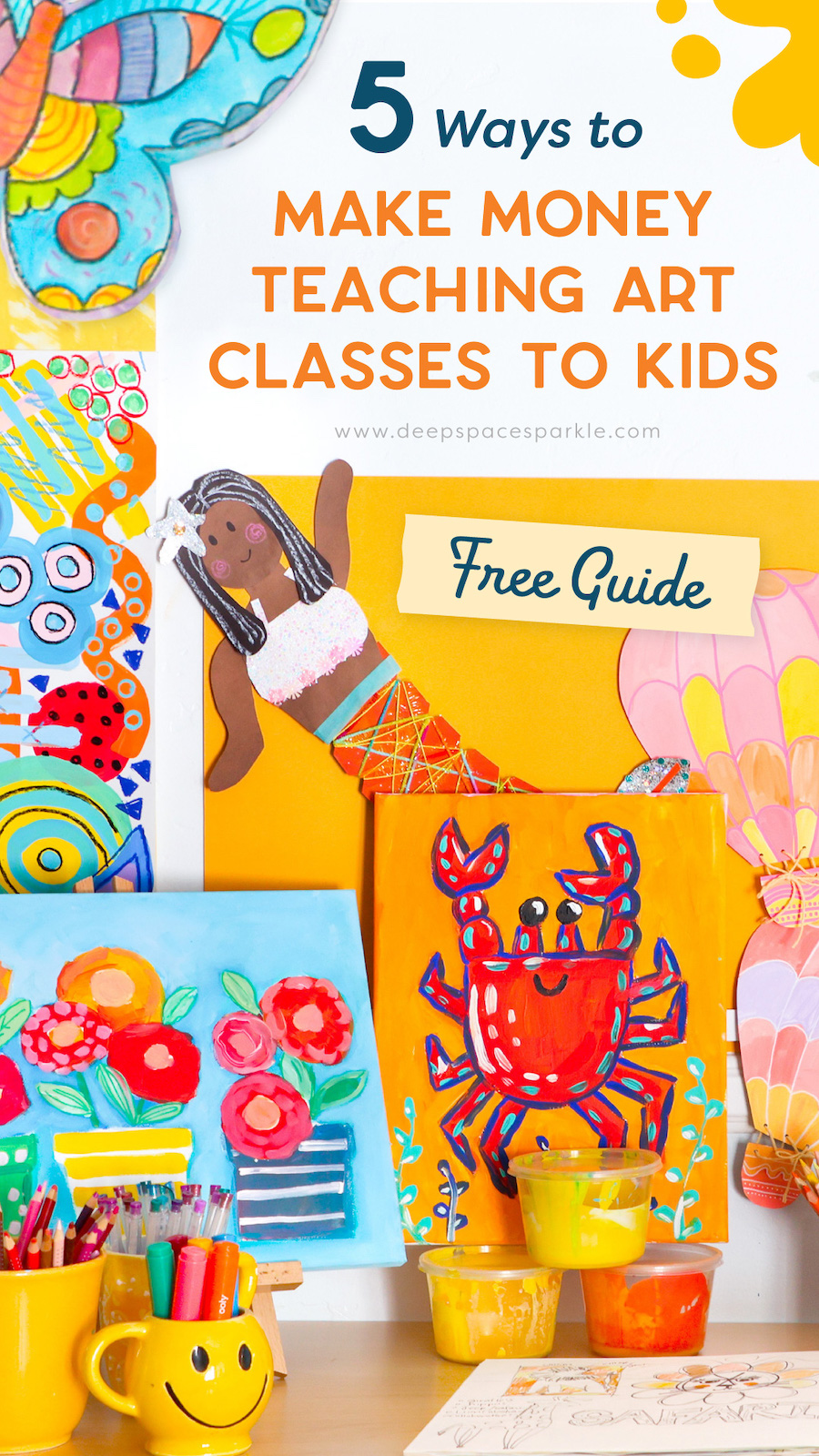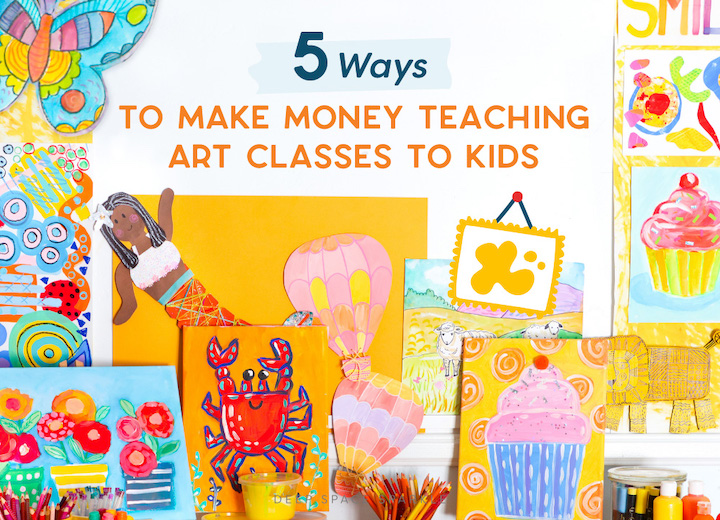Diving into the world of creative education business ideas for children is a series of endless possibilities. For art teachers and aspiring creative entrepreneurs, the classroom is just the beginning.
Retired art educators, new teachers seeking better work-life balance, and adventurous entrepreneurs are finding creative ways to teach art outside of school that brings in extra revenue and even provides a whole new career.
Creating a thriving art business is more accessible than ever. Whether you’re looking for a side hustle or a full-time career, the opportunities listed below are easy to start, offer great profitability and are guaranteed to fill your creative well.
In this post, I’m sharing 5 types of art businesses, who they are best for, how much you can earn and what you need to do to get started.

The FIVE TYPES of ART BUSINESSES FOR ART TEACHERS
1. Teaching Art Classes from your Home
Who is it for: Anyone! If you are a skilled artist, art teacher or creative who loves to share your expertise with children, teaching from your own home is ideal.
What you need before you start teaching in your home: This is the easiest business to start as it requires little paperwork, investment and effort. As long as you have a space to teach your students (dining room table, garage, sunroom, basement, etc), are comfortable allowing people into your living space and enjoy being a neighborhood celebrity, then this option is by far the easiest and most profitable.

You’ll also need some type of payment gateway (don’t overthink this… Venmo is great!), an email service provider to send sign-up and thank you emails and a welcoming space.
How much you can make: To be profitable with any businesses, you need to charge what you are worth.
Teaching in your home means that your expenses will be less than running a brick and mortar studio or having a membership site, but that doesn’t mean you should undercharge.
For most of our members in Primerry PRO, those who teach from inside their homes ranges from $10-$20 per art class/student for group classes and $25-65 per student/class for private lessons.
Those with specialized art spaces like converted sun-rooms or garages charge a bit more: $20-$35 per art class/student
2. On-Campus After-School Art Programs
Who is it for: If you have been teaching in a school system and are looking to add hours to your schedule or branch out entirely and create an after-school program, look no farther than your existing school.
Many schools don’t have dedicated art teachers (sad, but true) and are happy to work with an outside business or teacher to create an after-school art program.
What you need before you start: Depending on the school district, requirements vary but it’s safe to say that you would need to comply with the vetting process given to all employees or contractors to the schools. You will also need insurance but both of these are easily accomplished.

You’ll need to create your own art curriculum, bring your own materials and step into another teacher’s room with ease and leave it as you found it.
How much you can make: With on-campus programs, you can expect more students to sign up but parents will be looking for comparable fees as other after-school programs. Do your homework for your area but expect to charge anywhere from $10-20 per student/per class.
3. Brick and Mortar Art Studios
Who is it for: For artists and educators who want to go all-in in their community and be known as the place to create, there is no business model more suited for you.
This option is not for the dabbler or the toe-dipper. This business owner is someone who has a vision and will do anything it takes to create the space of their dreams.
What you need before you start: A location! That’s the biggest hurdle but once a location has been secured, the next most important steps are setting up your studio, creating your payment processes and class fees and setting up your classes.

How much you can make: This is highly variable as the amount you can earn is greatly affected by how many classes you teach, how many students you enroll and how much you charge per student.
The biggest difference with brick and mortar studios is that you can command a higher student fee because you are offering a high level art experience.
“The more students you teach and the more exclusive the art experience, the more you can charge.“
4. Teaching LIVE Online Art Classes
Who is it for: Anyone with a computer and the desire to connect with students through a screen are ideal candidates for live art online classes. Teaching through Zoom is one of the most popular and easiest platforms to use.
Live online classes can be used for just one student or dozens. It’s also great for teachers who live in rural or remote areas.
What you need before you start: Having a two-camera set-up is always helpful when teaching art. Children love seeing your face but also need to see the art project. You can find simple video equipment recommendations here.

With any online instruction, your target customer can be local or not. If you are connecting to your local community, the start-up requirements can be simple: just connect with your community and sign kids up with minimal marketing.
If you are striving to go beyond your community, you must become known in your field of expertise. This means having a website, email service provider to collect emails and a website to promote you and your classes.
How much you can make: Online classes can really run the gamut. Private classes are more expensive but large groups tend to be less. You can decide how much you want to earn and reverse engineer how much to charge per student. Anywhere from $9-$20 per student is average for live zoom classes.
This is really a sweet spot for art entrepreneurs who want to teach online but don’t have much knowledge of video editing and digital marketing to start an online course or membership.
If you want to learn how to get started the right way with online art classes, join Primerry PRO’s notification list. We’ll send you an invitation when we open our doors to our next enrollment.
5. Online Art Courses or Art Memberships
Who is it for: Art educators, artists and entrepreneurs who have an established email list, social media following and website.
What you need before you promote your course or membership: This is the most challenging of all business models as creating an online course or an online art club for kids requires you to do some legwork before you launch your program.

Having a website, social media following and the experience of selling digital products all help tremendously to the course or membership creator.
An email list is essential as this is who you will be selling to. So if you dream of starting a membership, your first goal should be to start growing your email list. There is nothing more discouraging than spending months (or years) on developing your course when you have no one to sell to!
How much you can make: Depending on your level of expertise, authority and knowledge of digital marketing, you can earn 4 to 6 figures with an online course of membership. The more you learn about courses and memberships sites, the more successful you will be. That’s part of what we teach inside Primerry PRO.
With group coaching, bite-sized and action oriented business courses plus an array of marketing materials to suit your business, PRO contains everything you need to start + grow your beautiful business teaching art lessons to children: online, from your home or in your own studio.
JOIN the Primerry PRO Waitlist
My life has changed so much since I learned how to create an art business that aligned with my skills, talents and lifestyle.
I can’t wait to hear which category appeals to you right now.
And if you are already running a business at home, brick and mortar or online, i;d love to hear from you, too!
What has been the biggest surprise for you?















I have always wanted to have an art class for children, dreamingly focused on those with disabilities. I am scared on starting, as I barely am able to pay bills as it is. I am so looking for a sign of hopefulness